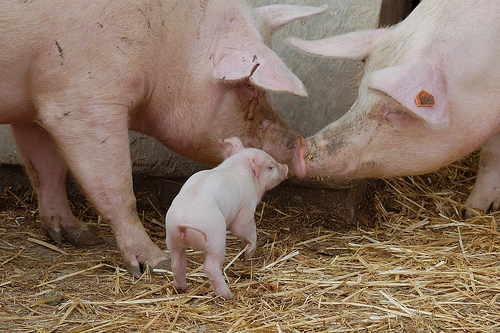What is the situation of backyard swine raising now?
In 2004, the output of the domestic swine industry, which contributes about 80% to total Philippine livestock population (LDC Bulletin No. 1), declined minimally after enjoying several years of continued growth, due in part to the closure of some backyard operations cause by tremendous rising feeds cost and drugs. This low level of hog production as reflected by the drop in animal and slaughter numbers recorded last year.

How could we solve the problem?
Seventy eight percent of the production cost in backyard swine production is feed cost and drugs, so we need to reduce the cost by utilizing farmers products , by- products and other available herbal plants for the care and management of swine.
What are the farmer product & by-product that can be used?
Corn and rice bran are the major product & by product that are readily available for feeding swine.
What shall we do with the corn to make it palatable for swine?
A village level type hammermill driven by a 5 horsepower gasoline engine or electric motor. The dried whole corn grain will be ground into cornmeal to make it palatable for swine.
How to formulate low cost feeds for swine?
By the use of shovel mix the feeds ingredients in the clean floor or large and wide basin.
1. Pre-starter (26% CP)- Mix 60% hog concentrate to 40% cornmeal.
2. Hog-starter mash (24%CP)- Mix 50% hog concentrate to 50% corn meal.
3. Hog-grower mash (18%CP)- Mix 50% hog concentrate to 40% cornmeal plus 10 parts rice bran.
4. Hog-fattening-Finishing mash (16%CP)- Mix 40%parts hog concentrate to 50% parts of corn meal plus 10% parts of rice bran.
4.Hog- broodsow mash (14%CP)- Mix 30 parts of hog concentrate to 60 parts cornmeal and 10 parts rice bran.
In herd management, what are the available herbal plants & their uses?
1. niog-niogan
For the control of internal parasites. Fed 15 pcs. matured and dried seeds to piglets 20-30kg. bodyweight for the control of ascaris.
For the growing-fattening, use 20-30pcs. of seeds and 30-40pcs for dry sow and boar.
2. bettle-nut(chinese variety)
Use 10-15 pcs. matured bettle nut for the control of round worm and pin worm 15-20 pcs. for dry sow and boar.
3. Neem-tree
For prevention and control of external parasites. Boil 1 part of neem tree leaves to 20 parts of water, let it cool and bath animals twice a week to smoothen the skin and at same time control mosquito bites. The decoction is also good for the control of diarrhea on piglets.
MMA syndrome can be remeded by flushing the uterus with neem tree decoction after 2 to 3 days after farrowing. In
replacement of intra-uterine cobblets. Leaves are repellant for mosquitoes.
4. Guava leaves
Boil 1 part of guava leaves to 10 parts of water. The decoction is use as anti-septic during castration and wound and best remedy for control of diarrhea on piglets.
5. Lagundi
Decoction of 1 part of the leaves and younger shoots to 10 parts of water is use for the control of common colds and
fever as drinking water for 3 to 5 days.
6. Kutsay
Poultice of the leaves can be applied to wound as anti-coagulant and anti-septic.
7. Akapulko and kakawati leaves
Poultice of akapulko and kakawati leaves is best remedy for skin diseases in swine.
How can we improve the quality of the pork?
One month before disposing the fatteners, cook corn grain first before feeding using rice hull, the meat will become pinkish red, tender, juicy and less fat content, the preference of the consumers.
Are there be changes on the usual cultural management of swine production?
The usual package of technology on swine production will be followed. The only thing that varies are the kind of feeds and the use of herbal plants for the herd health management.
What are some tips to improve backyard production enterprise?
• Right timing
See to it that your fatteners will be dispose during the months of November to February or festivities time.
• Right care and management
Tender love and care
• Right breed to raise
Tripple cross swine
• Right place to establish a project
The project must be away from highly urbanized residential area. Not in Muslim area.
• Right housing
Low cost, ventilated, cool and dry place.
• Right waste management
Tubular Polyethylene Digester (TPED) for biogas digester. Animal manure composting for organic fertilizer
• Right record keeping
Keep record of financial,marketing and other major activities under taken.
Contact persons:
JOSE T. AQUINO,JR.
TSS
MAURA S. MALAZO
ISS
Livestock FITS Center
D A, ISS III,
Sta. Barbara, Pangasinan

